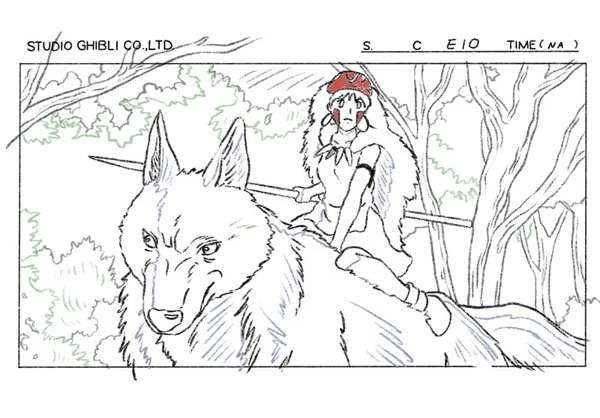Opinion: Studio Ghibli animation techniques revolutionize the film industry
December 17, 2020
Studio Ghibli is a Japanese animation film studio based in Tokyo and Hayao Miyazaki is the imaginative and visionary director behind many of the studio’s iconic films. From strange fantastical creatures to fully developed animated worlds, their films capture the mix of reality and animation wonderfully. Throughout the 22 films that the studio has made, Miyazaki has presented whimsical characters, developed unique storylines, and defined the importance of friendship. He creates a huge impact, not only on the viewers, but also on the animation and film industry. Some familiar films that Studio Ghibli have produced are Spirited Away, Howl’s Moving Castle, and My Neighbor Totoro.
The 79-year old Japanese animator has inspired several directors in Hollywood with his distinct directing style and ability to create immersive realism. For example in Guillermo del Toro’s Pan’s Labyrinth, there is a repetition of fantastical and dark themes which includes young protagonists that are commonly shown in Miyazaki features.
Another film that has been influenced by Miyazaki is Isle of Dogs, directed by Wes Anderson. The character and set design have a strong resemblance to Studio Ghibli films. In Isle of Dogs, there is a unique focus on the environment, which brings to mind the lush landscapes presented throughout Hayao Miyazaki’s works. Studio Ghibli is often seen presenting the destruction caused by climate change in their films, and Isle of Dogs contemplates the concept of living a sustainable life and slowing the effects of climate change. Wes Anderson has stated in an interview that: “With Miyazaki you get nature and you get moments of peace, a kind of rhythm that is not in the American animation tradition so much. That inspired us quite a lot.” Thematically, Anderson’s film overlaps with many of Miyazaki’s film elements, especially maintaining the theme of mankind overpowering its environment.
Studio Ghibli has also influenced American animation and cartoons like Gravity Falls, Adventure Time, and The Simpsons as they can be seen using Mizayaki’s techniques in setting layout, character design and even storyline.
[metaslider id=”6768″]
Studio Ghibli influences the industry by making films that are creative, original and new. Different recurring pacifism, environmentalism and coming-of-age themes are what Studio Ghibli excels in compared to the rest of the film industry. To do that they must start off at the base and build up different aspects of the films, which are different elements of animation. These elements often include world building, movement, and character design.
In all of the Ghibli films, Miyazaki brings the viewers into the world that he’s created through masterful animation and attention to detail. Studio Ghibli crafts immersive and unique stories that strike a balance between reality and fantasy. No matter how far-fetched or imaginary the story is, the world of a Ghibli film constantly feels tangible and realistic. Studio Ghibli often incorporates seemingly unimportant actions and elements, such as the characters sharing a meal or doing chores, or simply just sitting there, but they actually play an important role in relating to the audience and bringing them into the world where the movie takes place.
For example, in one scene during Spirited Away, the main character sits on a one-way train ride. This scene is quiet and gives the audience a sense of ambivalence. Nothing much is happening in this scene yet it creates a melancholic atmosphere. It doesn’t build the main character or let the audience know how she’s feeling; instead, the audience gets to feel however they want to feel during this scene.
[metaslider id=”6757″]
Miyazaki wrote in his book Starting Point, p.21 “Anime may depict fictional worlds, but I nonetheless believe that at its core it must have a certain realism.” In Spirited Away, the bathhouse, located in the spirit world, is the place where the spirits come to replenish themselves. While this is unbelievable in the real world, Miyazaki’s techniques relay a familiar and realistic feel to the details of the setting. The bathhouse is the main setting where most of the important events happen, but the viewers know that there’s a world outside the bathhouse.
For example, in the beginning of the movie it is indicated that the bathhouse and areas around it are surrounded by a large area of water due to the characters exploring the landscape of the world. There are also indications that this world is vast because of the different spirits that come to the bathhouse as well as the places that the main character travels. This lets the audience get a sense of the world inside the film and how it works. Studio Ghibli movies creates worlds that feel like they extend beyond the frames.
The word animate means to bring to life; it’s like acting. Animators must understand and empathize with their characters; they must consider what the character’s purpose or motivation is in the scene. Princess Mononoke is a film that exemplified great animation in movement because there are many scenes depicting war. The film is about the protagonist being attacked by an animal and travels to seek a cure from a deer-like god. There are a lot of actions in this film, as well as nature. There are times when the characters are walking through the forest and the wind is slightly blowing through the trees, their hair and cloth moves along with the wind and nothing is stiff, which creates a very relatable moment to the viewers.

The character design in Studio Ghibli films show strong character development. The emotions and traits of the characters are conveyed through attention to even the tiniest of details. Even the background characters are full of details which can be seen in their clothing and who they are with and where they are headed, which makes them seem like they have a purpose beyond filling up the background. Miyazaki’s movies approach animated art radically in a sense that they don’t focus on a good character overpowering an evil one. His inspirational mindset focuses on solving problems and not creating them. He conveys this message subtly, for example by giving the lead to strong and empowered women.
One film that exemplifies astonishing character design is Howl’s Moving Castle. This movie deals with war, responsibility, and identity. Character design here becomes particularly important, not only to help first impression, but also to help viewers understand a character’s growth. Howl, the male protagonist in the movie, is shown as a flamboyant, confident and mysterious character. Initially, he doesn’t seem to care a lot about others, until he meets the female protagonist. Throughout, his physical features also change many different phases from having different hair colors to a large black bird. Another character that has this internal and physical change is Sophie. At the beginning of the film she primarily wears gray but changed as her confidence grew. The changes in these two characters as well as others are physical but reflect how they are changing internally.
Studio Ghibli successfully embodies the rich tradition of animated storytelling by using techniques that are emotional, nostalgic and intriguing. Through animation, artistic style and storytelling, Studio Ghibli was able to inspire, influence, and impact the film and anime industry in a revolutionary way.


